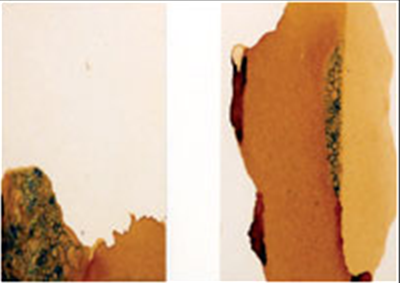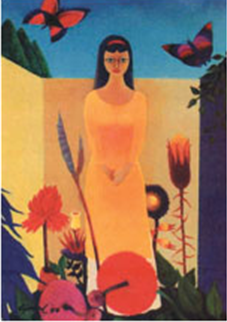Abdur Rahman Chughtai
This is a collection of articles archived for the excellence of their content. Readers will be able to edit existing articles and post new articles directly |
A R Chughtai
FLASH BACK: Young girls and A R Chughtai
By Saira Khanum
It appears that like every artist Chughtai was also interested in young girls. Though his point of view was different, and he considered them as the manifestation of innocence, purity and beauty. Young girls, painted by him, were sweet, idealised and imaginary, yet at the same instant these reflected the aesthetics of his time and the taste of the painter.
In reality, A. R. Chughtai did not approach young maidens as a specific theme or a subject outside of his normal pictorial practice, but works with this image, selected by Arif Chughtai, were recently displayed at the Chughtai Museum in Lahore. This institution, with the efforts of Arif Chughtai, continues to exhibit works of Chughtai arranged around different ideas and interesting topics. Previously a similar show about young boys was held, and the latest exhibition was also an attempt to showcase another such series.
Actually, it is not often that an artist choses to work in a series, since each creation is connected with the overall concerns of the artist besides existing as a separate entity/experiment. However, there are a number of examples in the art world, when artists consciously worked in series; and the most notable among those was the French Impressionist Claude Monet. He painted several canvases with identical visuals, for instance the views of Rouen Cathedral, hey stacks and water lilies. All of these canvases reveal an artist’s urge to explore multiple aspects/possibilities of a single subject. Usually these relate to formal or conceptual elements, and help in comprehending the creative process of an artist.
Likewise, the exhibition at Chughtai Museum, served to unfold various features of Chughtai’s art. The artist, who nowadays is acclaimed and recognised as the ‘National painter’ or the ‘Artist of the East’ can not be confined into such categories. (A fortunate situation for him and for the art in general, because if one starts classifying and labelling a creative person it is like limiting his aura and reducing his vision.)
Hence in the exhibition ‘Young Girls’ Chughtai appeared to be beyond such demarcations. Merely, because these portraits unfolded a wide range of his influences and interests. Beginning from the Bengal School, along with the Indian features, to the compositions inspired from the European art, A. R. Chughtai demonstrated how an artist can utilise a variety of styles and movements, and formulate his individual visual vocabulary. Dark complexions of female figures, almond shaped eyes, prominent outlines and dark hues reminded of Ajanta fresco paintings, yet he was able to translate the art of the past into a contemporary idiom.
This capacity, of transforming the heritage into a living language, was complemented with another capability in the art of Chughtai; that of appropriating the outside influences and turning these into personal expressions. In his work, one could identify the traces of Western aesthetics, but these elements did not emerge as alien substance. On the other hand, these were assimilated in such a way that it became hard — even impossible to discern foreign influences and the historic imagery.
With his comprehensive knowledge of tradition and visible interest in modernity, Chughtai was able to fabricate an art that is unique in its essence, and today seems more relevant and meaningful —especially after the present day revival of miniature painting in Pakistan. However, the artist did not seek to recreate miniature, as he was more inclined to shape an aesthetics, which defied any labels and definition. The wash technique (derived from the Japanese paintings) and the arabesques and floral patterns from the Persian painting were combined to develop a highly individual imagery.
All these formal aspects were on view in the recent exhibition, and more than anything, the show served to study the evolution of an artist. That how in his early painting, the presence of Bengal School was pronounced, which led to ‘Oriental’ imagery in later paintings. Works from the early periods are simple in composition and sparse in terms of chromatic schemes, but later group of paintings contained decorative elements such as jewellery, patterns on the dresses and rather busy backgrounds. Yet in both types of work, the unmistakable mastery of Chughtai with the line that denoted volume, besides having a lyrical character, was visible.
Probably the most important feature of the show at Chughtai Museum was to recall the initiation of portrait in our art. Historically, portrait as a genre was not much practiced in the Subcontinent. Apart from a few examples of royal portraits (executed on ivory and paper) portrait was not a popular art form. However one finds numerous samples of likeness in miniatures — especially from the periods of Jehangir and Shahjehan, but to make a single face of a known person as a single work of art was not much explored prior to British period.
It was only after the invention of camera and the arrival of English artists in the art of India, portrait assumed an independent significance/status. Perhaps it has to do with the idea of individuality — discovered after the age of enlightenment and modernity — which led to the increase of this genre, first in Europe and then in South Asia.
In that respect, the images of young girls, made by Chughtai, were not just feminine faces, but these appeared portraits of specific personalities, all rendered in his individual style. The exhibition marked, reminded and reaffirmed the importance of A R. Chughtai, not in terms of our history, but in the context of present art in Pakistan — to which Chughati seems to be an integral and logical part than many others, who are although alive, but busy producing works which can be described as dead art.
Top: Modern girl Top: For the victor
M. A. Rahman Chughtai
A legend remembered
By Marjorie Husain
Every year, on the 17th January, commemorating the death anniversary of Pakistan’s legendary artist M. A. Rahman Chughtai, an exhibition of his work is held at the Chughtai Art Home, in Garden Town, Lahore. On the most recent occasion, the theme of the work was ‘Mothers’, illustrated by twenty-two of Chughtai’s paintings, ravishing watercolours of graceful forms set amongst backgrounds of delicate design and glimpses of landscape. There were also a number of drawings of which the earliest was dated 1918. It was a period in the artist’s life when he was a teacher in the newly established photo-lithography department of the Mayo School of Art, where Lionel Heath was the principal. Looking at the work was like stepping back into history. It was touching to note the care with which the artworks were displayed, particularly the last drawing in sequence executed by Chughtai on the day he died which carried a footnote; “Note the tremulous lines”.
The Chughtai Art Home, Lahore was established and is run by the artist’s only son, Arif Rahman Chughtai, who has dedicated his life to his father’s work and memory. His knowledge of the great artist’s life and times is phenomenal. He records in brochures and catalogues each detail of his father’s existence; every word that is written by others is examined, and in cases of erroneous remarks, acted on. The incidents, happenings, exhibitions, the literary output - for Chughtai was a prolific writer - the people in his life, good times and bad, are all documented for posterity. Appreciation received for the artist’s work is also documented. Arif details an incident in 1922, when Chughtai’s painting; The Passing of Shah Jehan, painted in 1919, was purchased from exhibition by Rana Chandra Shamsher Jung Bahadur, then Prime Minister and Hereditary Ruler of Nepal. The artwork was priced at fifteen hundred rupees, at that time an enormous sum, and Chughtai had suffered considerable criticism, and jealousy for thus pricing his work. The vindication of his talent was never forgotten. Years later, on the artist’s thirtieth death anniversary, a catalogue with details of the artist’s life and work brought out by Arif, was dedicated to Rana Chandra Shamsher Jung Bahadur, “A lover of the arts who sought solace in the art of M.A Chughtai of Lahore.” On that anniversary in 2005, Arif wrote his personal dedication to his father. ‘On January 1975, I made a promise to you. I have kept it for thirty years. Now ready for the next thirty years.’
As custodian of the M.A.Rahman Chughtai archives, Arif Rahman Chughtai maintains with utmost precision and care, each token of his father’s life and work. The artist’s years with the Mayo School of Art, first as student then as teacher are noted. One reads of his encounter with the founders of the Bengal School of Art, while taking further training in photo-lithography at the Calcutta Government Press, and his confidence in his own capabilities. As he is reputed to have said: “Those who have to grow can sprout from stones”. Chughtai was never aligned to the New Bengal School of Art, his son informs us, and it is on record, that he formed a Punjab School, which included artist friends and relatives.
Chughtai’s life, from the material available to us, appears as a fascinating saga. One gleans the impression of a hugely talented, dedicated artist, committed to his muse and constantly working. At the same time, very much a family man who enjoyed his wife’s cooking, flying kites, picnics by the river Ravi, and fishing expeditions. He traveled throughout Europe, taking time out to practice etching at the Central Institute in London. Chughtai was the first Oriental artist to have his work included in the Annual Summer Exhibition at the Royal Academy, London, in the 1930s, and he found and relinquished a life-long love.
In one of the publications brought out by Mr.Arif Chughtai recently, there is an article titled: Double Barrel Game and causes of Confusion, in which the author details12 facts on identifying the work of the Master. In another article, he also very interestingly puts on record the fact of the existence of different versions of the same paintings done by the artist himself with the knowledge of the buyers and as a requirement for his proposed Museum. Arif Rahman Chughtai is guardian and custodian of his father’s wishes to preserve his art for posterity. Now he wonders who will carry on in his place. This tragic fact of an artist’s life is a fearful reality. It was one of Bashir Mirza’s fears, and where now would Ahmed Parvez exist without Wahab Jaffer’s collection. This factor sourced Jamil Naqsh’s efforts to permanently house his works for posterity. These are just a few examples of the very real shadow that haunts the artist in his desire to live on in his work.
Chughtai was the one Old Master I never had the privilege of meeting, but I heard many stories from friends, and his work is the most revealing aspect of the man. Anna Molka Ahmed spoke of him warmly as a great encouragement in her efforts to promote art in the country. Not only exhibiting his work in the annual exhibitions she arranged at the Punjab University, but also actively taking part as judge and regularly donating a Gold Medal to the most promising of the younger artists. I thought of these talks while I roamed the gallery, the enigmatic man who left so much behind, a man who cherished and cared for his mother and who poured his feelings into paintings simply titled, ‘Mothers’.






